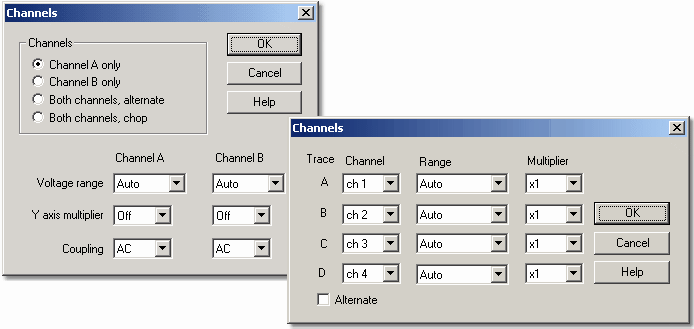| PicoScope 2000/3000 Series |



|
From the Settings menu, select Channels....

These dialog boxes enable you to select which input channels to display in the active window and to set the input voltage ranges.
Channels
You can collect data from a single channel, or from two or more channels. If you want to collect data from more than one channel, there are two modes available to you: Chop mode and Alternate mode.
Voltage range
The oscilloscopes have a number of input voltage ranges. You can either specify an input voltage range, or select Auto, which means the oscilloscope will automatically adjust the voltage range to suit the input signal.
Note: Auto mode does not give good results with trigger signals that occur only once, as PicoScope does not know in advance what range to use.
If you add custom ranges to scale the input from sensors (for example, pressure or acceleration), the custom ranges will appear here. You must select them to activate them.
Y axis multiplier
When a Y multiplier is set at Off, the computer displays the full voltage range over the height of the window.
If you change the Y multiplier to x1, the computer initially displays the full voltage range, but also displays a scroll bar at the left or right of the window. You can use this scroll bar to move the trace up or down, to move it away from other traces.
If you change the Y multiplier to x2 or above, the computer displays only half of the voltage range scaled to twice normal size. The scroll bar now controls which portion of the voltage range is displayed.
Coupling
You can switch PicoScope 2000 and 3000 series oscilloscopes between AC and DC using this drop-down menu, or you can use the controls on the instrument toolbar.